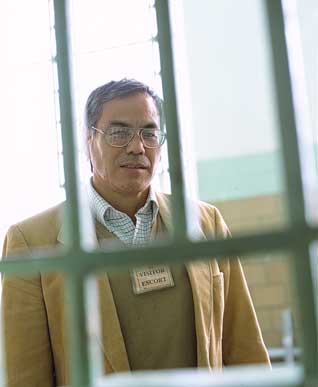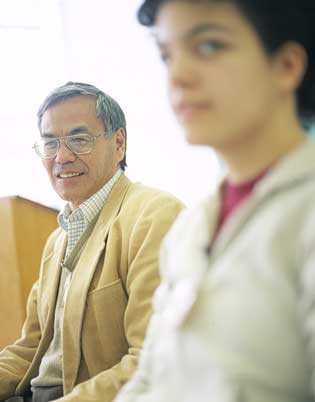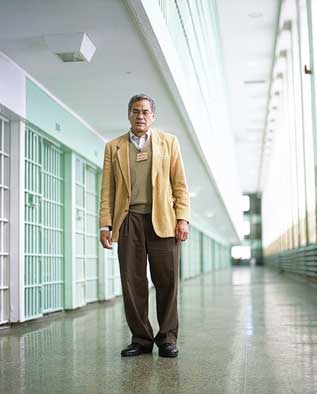The Classroom Inside: Green Haven Prison
The maximum-security prison in Stormville, New York, is only a 30-minute drive from Vassar, but it might as well be on another planet. In contrast to the beautifully manicured campus and prestigious academic environment, the facility sports armed corrections officers, violent offenders, and barbed wire. But the two places do have something in common — the Green Haven Prison Program.
Long-time Vassar Religion and Africana Studies Professor Lawrence Mamiya calls the program an "‘experiment in transformative education.’ I’ve seen the lives of [inmates and] Vassar students change," he said. A radical and challenging program that promotes self-exploration and social consciousness, the Green Haven Prison Program has impacted hundreds of Vassar students and inmates since its inception in 1979, when Mamiya started bringing Vassar students into discussion groups facilitated by inmates at Green Haven Correctional Facility.

Professor of Religion and Africana Studies Lawrence Mamiya has taken his classrooms inside Green Haven Prison for more than 20 years.
The purpose of the dialogues is for students to provide information about what is happening in the outside world, and for prisoners to share their experiences of life in prison. Discussion groups initially focused on current events, but have since taken on topics ranging from domestic violence to fatherhood. Year after year, students discover something unexpected behind the walls of Green Haven Prison — something human and vital that often affects the course of their lives and directs their career choices. As Amie Fishman ’98 said, "In Green Haven, I had one of those moments when I felt the path of my life turn sharply."
Professor Mamiya’s involvement and interest in prison issues has its roots in his own activism. In the 1960s he worked as a community organizer in Harlem and was part of the civil rights movement in the Deep South. During Mamiya’s earliest years at Vassar, he integrated occasional prison visits into his "Social Change in the Black Community" and "Religions of the Oppressed" classes. In 1979, after one such visit, a Green Haven prisoner named Tyrone Larkins asked Mamiya if he would return with his class. Mamiya agreed, but did not follow up on his promise until Larkins had his civilian counselor put in weekly reminder calls. A month later, Mamiya committed himself to forming a Friday afternoon discussion group at Green Haven between inmates and students.
The initial Vassar Green Haven program, called the Group Transition Program, was part of a 16-week cycle of classes designed in the mid-’70s by a collection of Green Haven prisoners and known as the Think Tank. Many members of the Think Tank had been transferred to Green Haven from upstate New York’s Attica Prison after the deadly riots of 1971, in which prisoners seized control of an exercise yard at Attica and took guards hostage. Their demands were aimed at achieving more humane prison conditions. Prisoners had been protesting lack of adequate medical services, poor eating conditions, political persecution, physical brutality, and exploitation of their labor without the benefit of real job skills. Four days after the rebellion began, New York State troopers stormed the prison and killed 43 inmates and guards. In the aftermath of Attica, many prisoners were transferred elsewhere, to prevent further organizing.
In the interest of assuaging prisoners’ discontent and providing them with some basic needs, Green Haven’s Pre-Release Center — an inmate-led, self-help program developed by the Think Tank — was born. The Think Tank’s philosophy was that inmates could and should provide peer counseling to other inmates in order to help them face the parole board and, ultimately, to transition back into society. Members included political prisoners and community organizers, such as Eddie Ellis, a former leader of the New York City Black Panther Party.
Another Think Tank member, Latif Islam, was a peer counselor at the Pre-Release Center. Although he did not personally attend sessions with Vassar students, Islam says the program was "a ray of hope" for the participants he knew. He remembers Mamiya "coming in year after year with the steadfastness and fortitude to continue." Islam was incarcerated at Green Haven from 1973 to 1980 and went on to receive his diploma from Marist College in 1984. Since then, he has helped hundreds of men from Green Haven move through and graduate from Marist’s higher education program. He is now an adjunct professor there as well as the director of youth services at Poughkeepsie’s nonprofit Family Partnership Center, where Vassar graduate Ana Vuk-Pavlovic ’01 assists him.

Former Green Haven Program participant Ana Vuk-Pavlovic '01 (front) continues to volunteer at the prison.
The Pre-Release Center and the Group Transition Program at Green Haven were the first of their kind in the nation, and have been used as models throughout the country. These programs have helped prepare men for release back into their communities through practical skills workshops. By partnering with Vassar, they have also fostered rehabilitation through the formation of respectful human relationships. And it is clear from interviews with alumnae/i that those one-on-one relationships with prisoners were extremely important in the development of the students’ lives and values as well. Jenny Schlaifer ’97, who after Vassar worked with an adult education program for incarcerated women in Seattle, Washington, talked about the impact of forming "a tangible connection that was made in a seemingly inhumane place." Added David Jaeger ’97, "There are people in prison who aren’t dangerous, but who are, in fact, beautiful."
Although the first few semesters at Green Haven were slow (at one point, there was only one student going into the prison with Mamiya), it didn’t take long for the program’s popularity to skyrocket via word of mouth. At its peak, 60 Vassar students per semester made the weekly drive, passed through Green Haven’s metal detectors, and met with groups of prisoners. Last semester, the program was limited to 34 students, so they would not outnumber the prisoners in the program. Every semester there is a waiting list.
What makes the program so popular? Mamiya believes that for Vassar students and the inmates, "this is one of the few opportunities they have to cross race and class boundaries. Many Vassar students have grown up in segregated situations," he said. "If you grew up in a white suburb and went to white schools, you barely had contact with minorities. This is one of the few chances [a white student might] have to talk to, say, black and Latino men, over a long period of time. It works the other way, too. Somehow, in that relationship, it [becomes] a very powerful experience."
When the college began offering students credit for the Green Haven program in the late ’70s, Helen Miringoff was the head of Vassar’s Field Work Office. Mamiya described her as a "feisty woman who wouldn’t take no for an answer." She was instrumental in getting the program off the ground and was especially skilled at making sure students were allowed into the prison when Green Haven administrators or the prison bureaucracy threatened to block their way. Another instrumental figure in the history of the Green Haven Program is Mark Cladis, associate professor of religion. In 1990 he began taking students into the prison and has continued to do so each semester. Cladis said, "My respect, my appreciation, my love of Vassar students began when we started to travel together to Green Haven. And I will always be grateful to Larry Mamiya, for his courage and commitment and for his asking me to visit Green Haven with him."
Through Green Haven, Vassar provides students with an opportunity to go beyond words and letters, to reach into the heart of their own socialization, and to question stereotypes. Cladis, for his part, considers the men at Green Haven to be "skilled teachers who have experienced the full drama of life." Students, too, who go through the program realize that there is a texture and depth of learning that cannot be gained through books or lectures. "I needed to see the real-life workings of the criminal justice system. The Green Haven program is a great example of a well-rounded, academic experience. It was touching. It hit me like a brick, and it changed my life," said Rob Hope ’00. One of the most important aspects of the program, however, is that it allows participants to explore what it really means to be human. As Cladis put it, "I have come to understand (in the deepest sense) that the difference between those in and those out of prison is very slight. We have all ‘fallen short.’ We all have failed in important aspects of life. We [also] all possess human goodness. We all have dignity. Even failure — how we deal with it — is part of our dignity."
Evidence of the impact of the program can be seen at the Vassar Green Haven Program reunions. Each year since 1999, a student committee brings together Vassar students currently participating in the program, Vassar alumnae/i, and ex-prisoners who have "graduated" from Green Haven. The reunions — now open to members of the larger community, who attend in moderate numbers — offer students, family members of prisoners, community activists in the field, alumnae/i, and former prisoners a chance to exchange knowledge, network, catch up, and form new alliances.
My own life attests to the influence of Vassar’s Green Haven program — the most tangible "real-life" education I received at Vassar. Since graduating in 1998, I have been involved in Canadian and American books-to-prisoners programs, taught creative writing at Dutchess County Jail, and writes articles on prison issues. I feel drawn to educate others about the realities of prison and the criminal justice system, as I continue to learn myself. I never expected to be invested in the issues of prisoners’ rights and criminal justice in the way that I now am. But as Professor Mamiya put it, "When you deal with oppressed people, that experience is so deep and so powerful that it can provide opportunities for transformation — for changing your views of the world and how you relate to people."
When I spoke with Mamiya in Poughkeepsie last fall, he told me stories — about a Vassar graduate who had gone to the Peace Corps in Mali on a recommendation written by Green Haven prisoners; an alumnus who became a lawyer in order to represent First Nations prisoners in Canada; and a former student from Zimbabwe who went to South Africa after Vassar and tried to start a prison program in the same vein as Green Haven.
In speaking with other Vassar alumnae/i, I have found a diversity of impassioned prison activists, volunteers, and visionaries. The common inspiration was their experience at Green Haven, although each has integrated prison work into their post-graduate life in a unique way.
Having spent two semesters at Green Haven, Fishman, an ethnobotany major, said the experience "has fueled all of my work since then. It just wasn’t an option not to continue the work. As a white person coming from economic privilege, I’d really never thought much about prison. Stepping into one was an amazing experience. It really broke my heart to see people who had great things to contribute to the world — and who had made some very bad mistakes — being denied the opportunity to contribute."
With San Francisco’s nonprofit Center on Juvenile and Criminal Justice, Fishman took a job as a caseworker in the county jail, acting as a liaison between the prisoners and the deputy’s and sheriff’s departments. The center’s mission is to reduce societal reliance on incarceration as a solution for social problems, and Fishman advocated for the release of prisoners that were not a threat to society — such as homeless people, addicts, and those with mental illness. After two years in that position, she now conducts research and social histories on people with felony charges. The information she collects is presented to a judge, along with recommendations for alternatives to sentencing, such as community service or probation.
Both Jaeger and Vuk-Pavlovic expressed a desire to continue the work started by the Vassar Green Haven Program. For two years, Jaeger has been involved in fundraising, grant writing, and volunteer outreach for the Prison Book Program in Boston. "Before my senior year, prisons were not on my radar screen. I got an insight into an institution that a lot of Americans trust but don’t know much about," he said. Jaeger, who refers to the Green Haven Program as his "anti-racist education at Vassar," has been trying to get the African Diaspora encyclopedia into as many prisons as possible.

As Latif Islam’s assistant, Vuk-Pavlovic continues to work with inmate groups in Green Haven. She also helps parolees make the transition back into society. She refers to the men she has met at Green Haven as "social leaders" and is considering going to law school so that she can defend prisoners.
Hope recalls how easy it was to give up his initial pretenses with the men from Green Haven. Coming from a suburban, Midwestern background, Hope at first thought he needed to "pretend like I knew what they were talking about. But [the prisoners] were so non-threatening; they were straight-forward and encouraged honesty." Now, he works for Vera Institute for Justice, a nonprofit in New York City that attempts to solve criminal justice problems by building nonprofit organizations from successful models. Hope has been involved in evaluating an alternative drug treatment program that Vera initiated. He also is helping to build a national archive of criminal justice statistics used for reports on race, sentencing, and incarceration.
Although she was a student before the Green Haven program’s inception, Zell Draz ’45-44 was an ardent supporter of the program and funded the last two reunions. She became actively involved in prison work in 1987, working for the Massachusetts-based Alternatives to Violence Program, which helps prisoners channel their anger in positive ways. Sadly, Draz passed away last summer. Her son Griswold estimated that she had conducted over 90 violence prevention workshops with prisoners over the years.
It’s not every day that college students, professors, and prisoners come together with sincerity and gratitude for the opportunity to build bridges. The waters that need to be spanned are vast, but many people have left Green Haven and Vassar with a determination to continue the work they started in the prison program. Just as Green Haven’s Think Tank of the ’70s created a national model for empowering and serving prisoners, Vassar created a model designed to educate and inspire students. It is a model that might well serve other institutions of higher learning.
Linet ’98 is a freelance writer in Montreal, Canada. She regularly volunteers at a books-to-prisoners program.
Photos by Mark Mann
